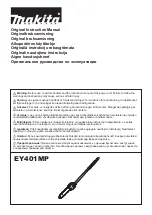
www.scheppach.com /
+(49)-08223-4002-99 /
+(49)-08223-4002-58
GB | 29
screw (49) by turning in a clockwise direction.
• Tighten the locking handle for the saw table (21)
again by turning clockwise.
• Also undo the nut (50).
•
Adjust the screw (49) sufficiently that the saw table
touches the underside.
•
Retighten the nut (50) to fix the screw (49) in po
-
sition.
• If necessary, set the scale pointer (51) to 0° on the
graduated scale (52). (Fig. 11)
9.9. Which saw band to use
The saw band supplied in the band saw is intended
for universal use. The following criteria should be
considered when selecting the saw band:
• It is possible to cut tighter radii with a narrow saw
band than with a wide saw band.
• A wide saw band is used if a straight cut is re-
quired. This is important in particular when cutting
wood. The saw band has a tendency to follow the
wood grain and therefore deviates easily from the
desired cutting line.
• Fine-toothed saw bands cut more smoothly, but
also more slowly than coarse saw bands.
ATTENTION:
Never use bent or torn saw bands!
9.10. Replacing the saw band (Fig. 1a+1b+3+15)
• Set the saw band guide (5) at approx. half height
between the saw table (7) and machine frame (16).
• Undo the cover locking mechanisms (10+13) and
open the side covers (11).
• Remove the guide rail for the parallel stop (26) in
reverse order (see 9.2)
• Relieve the Bandsaw blade (22) tension by turning
the clamping screw (1) anti-clockwise.
• Remove the Bandsaw blade (22) from the saw
band rollers (2+8) and through the slot in the saw
table (7).
• Place the new Bandsaw blade (22) centrally on
both saw band rollers (2+8). The teeth of the Band-
saw blade (22) must point downwards in the direc-
tion of the saw table (Fig. 6).
• Tension the Bandsaw blade (22) (see 9.4)
• Close the side cover (11) again.
•
Then fit the guide rail for the parallel stop again (per
9.2).
9.11. Replacing the table insert (Fig. 14)
In case of wear or damage, the table insert (6) must be
replaced; otherwise there is an increased risk of injury.
• Remove the worn table insert (6) by lifting it up and out.
• Installation of the new table insert takes place in
reverse order.
9.12. Extraction nozzle (Fig. 1b)
The band saw is equipped with an extraction nozzle
(20) 100/40 mm for chips.
Only operate the device with a suitable extraction
system. Check and clean the suction channels at
regular intervals.
9.13. Push Stick retainer (Fig. 13)
The Push Stick retainer (48) is pre-mounted on the
machine frame. If unused, the Push stick (27) must
always be stowed in the Push Stick retainer.
10. Operation
10.1 On/Off switch (12) (Fig. 16)
• To turn the machine on, press the green button „I“.
•
To turn the machine off again, press the red button „0“.
• The band saw is equipped with an undervoltage
switch. With a power failure, the band saw must
be switched back on again.
10.2. Parallel stop (Fig. 17)
• Press the clamping bar (H) of the parallel stop (25)
upwards
• Position the parallel stop (25) to the left or right of
the saw blade (22) on the guide rail for the parallel
stop and set to the desired measurement.
•
Press the clamping bar (H) down to fix the parallel
stop (25) in place.
• Make sure that the parallel stop (25) always runs
parallel to the Bandsaw blade (22).
8.3. mitre gauge (53) (Fig. 1+22)
• push the mitre gauge (53) into a groove (a) in the
saw bench.
• Release the grip screw (b).
• Turn the mitre gauge (53) until the desired angular
dimension has been set. The arrow on the lateral
stop indicates the set angle.
• Retighten the grip screw (b).
10.4. Angled cuts (Fig. 2+12+19)
In order to execute angled cuts parallel to the Band-
saw blade (22), it is possible to tilt the saw bench (7)
forwards from 0° - 45°.
• Loosen the locking handle for saw table (21).
• Tilt saw bench (7) forwards, until the desired angle
is set on the degree scale (52).
• Retighten locking handle (21).
ATTENTION:
With a tilted saw table (7), the paral-
lel stop (25) must always be fitted to the right of the
Bandsaw blade (22) in the working direction. This
prevents the workpiece from slipping.
11. Working instructions
The following recommendations are examples of the
safe use of band saws.
The following safe working methods should be seen
as an aid to safety. They cannot be applied suitably
completely or comprehensively to every use. They
cannot treat every possible dangerous condition and
must be interpreted carefully.
• Connect the machine to a suction unit when work-
ing in closed rooms. A suction device which con-
forms with commercial regulations must be used
for suction in commercial areas.
Summary of Contents for 5901502938
Page 5: ...www scheppach com service scheppach com 49 08223 4002 99 49 08223 4002 58 5 21 20 19 18...
Page 6: ...www scheppach com service scheppach com 49 08223 4002 99 49 08223 4002 58 6 22 53 b...
Page 47: ...www scheppach com service scheppach com 49 08223 4002 99 49 08223 4002 58 47...
Page 48: ...www scheppach com service scheppach com 49 08223 4002 99 49 08223 4002 58 48...
Page 50: ...www scheppach com service scheppach com 49 08223 4002 99 49 08223 4002 58 50...
Page 52: ...www scheppach com service scheppach com 49 08223 4002 99 49 08223 4002 58 52...
















































